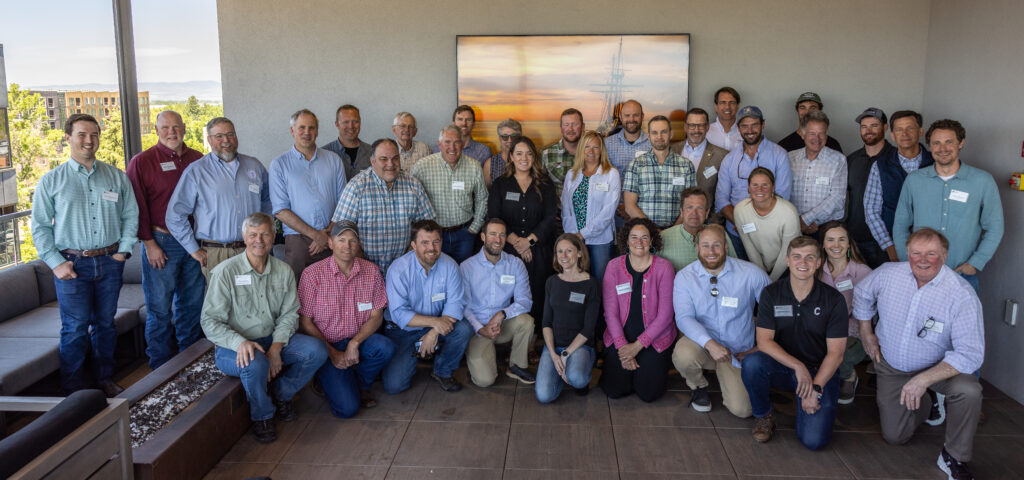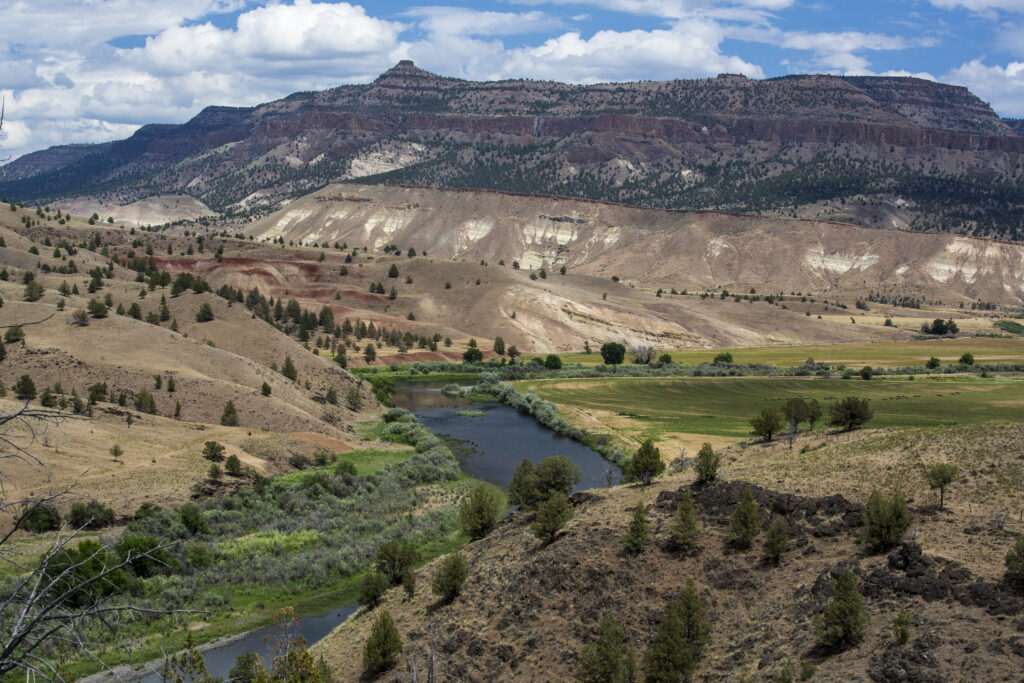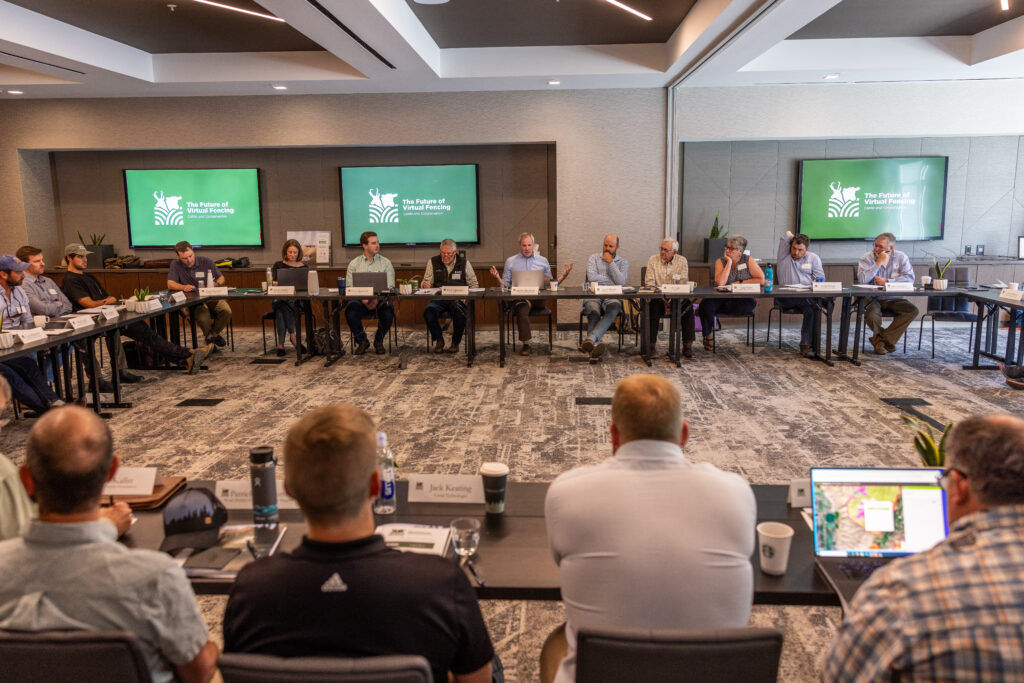
We, the undersigned, offer our organizations’ support to enact the proposed recommendations.
*Universities are mentioned only for identification purposes and not as an endorsement.
Overview
Virtual fencing is an innovative land management tool that offers substantial benefits for both ranchers and wildlife. By reducing the need for traditional physical barriers, this technology enables flexible and precise grazing practices that can enhance wildlife habitat, improve water quality, and promote soil health. While early adopters have demonstrated the technology’s potential, widespread deployment will require coordinated support from federal and state agencies, private landowners, and conservation organizations.
This report summarizes policy opportunities to advance virtual fencing as a conservation tool. The recommendations highlight key areas where policymakers can act to support its broader implementation, building on discussions from a 2024 workshop on virtual fencing hosted by the Property and Environment Research Center (PERC) and the Beyond Yellowstone Living Lab. By working with landowners and other stakeholders, leveraging public-private partnerships, and addressing regulatory challenges, virtual fencing can help promote sustainable ranching while conserving critical habitats and supporting wildlife movement across private and public landscapes.
Key Recommendations for Policymakers
- Integrate virtual fencing into federal conservation programs
- Promote flexibility in federal programs and grazing rules
- Streamline permitting and reduce regulatory barriers
- Improve agency coordination and consistency
- Establish and fund pilot projects in high-value conservation areas
Introduction
In the vast landscapes of the American West, traditional physical fences crisscross the terrain, dividing lands for ranching and agricultural use while simultaneously disrupting wildlife movement. These barriers present significant challenges for species like mule deer, elk, pronghorn, bighorn sheep, and sage grouse, whose movements and migratory routes are often interrupted by physical obstacles. Furthermore, building and maintaining physical fences is not only time-consuming and costly for landowners but also creates rigid boundaries that limit flexibility in managing livestock and restrict options for protecting sensitive habitats.
Virtual fencing offers a promising alternative. This emerging technology enables livestock management without the use of traditional physical fences. Animals (primarily cattle) wear GPS-enabled collars that emit sound, vibrations, and mild electric pulses to guide their movement to encourage them to stay within—or deter them from entering—designated areas. These virtual boundaries can be adjusted remotely through a base station, cell phone signal, or cloud-based software, offering ranchers flexibility in managing their herds while protecting sensitive environmental areas like wetlands, riparian zones, highly erodible soils, or wildlife corridors.
Unlike traditional fencing, which can disrupt wildlife movement and requires costly maintenance, virtual fencing is adaptable and can enhance habitat conditions and connectivity for a wide variety of species. Additionally, it reduces the time and labor required to manage livestock and enables more precise boundaries, allowing ranchers to maintain more flexible grazing practices and keep cattle out of areas of potential wildlife conflict. As federal agencies and conservation groups prioritize landscape-level conservation, virtual fencing emerges as a critical tool that aligns with both ecological and economic objectives.
Unlike traditional fencing, which can disrupt wildlife and movement and requires costly maintenance, virtual fencing is adaptable and can enhance habitat conditions and connectivity for a wide variety of species.
What is virtual fencing?


Virtual fencing is an emerging technology that is reshaping land management practices by allowing ranchers to manage livestock without physical barriers. Using GPS-enabled collars that communicate through the use of wireless base stations and/or cellular networks, virtual fencing systems guide cattle across landscapes while leaving critical habitats accessible for wildlife. This innovative approach is not only providing greater flexibility for ranchers, but is also creating opportunities to enhance wildlife conservation by minimizing habitat fragmentation.
As policymakers and land managers seek solutions that balance agricultural productivity with conservation goals, virtual fencing offers a transformative tool. To realize its full potential, there is a need for clear, coordinated policies that support its adoption and integration into existing federal programs.
The Role of Virtual Fencing in Enhancing Conservation

Virtual fencing offers considerable benefits for wildlife conservation, especially in areas where traditional fencing hinders species movement or causes wildlife entanglements. Migratory ungulates like elk and pronghorn often encounter physical barriers that fragment their habitats, leading to increased mortality and decreased fitness. Birds like sage grouse are also at risk of injury from traditional fences.
Virtual fencing can also allow ranchers to create exclusion zones around sensitive areas like breeding areas or riparian corridors, where cattle grazing can damage habitats vital for species such as sage grouse and spawning salmon. In addition, ranchers can use virtual fencing technology to monitor, concentrate, or rotate cattle grazing to reduce predation risks.
Case Study: Promoting Rangeland Resilience in Oregon
In Oregon, Gilliam County Soil and Water Conservation District partnered with four ranchers to pilot virtual fencing after wildfires devastated the region. The project secured $275,000 to deploy virtual fencing on approximately 50,000 acres. To replace the fences that were lost in the area, the conservation district estimated it would cost $9.5 million.1Alejandro Figueroa. “How ‘Invisible Fences’ Can Make Oregon Rangelands More Resilient Against Wildfires.” Oregon Public Broadcasting (Sept. 27, 2024).
Virtual fencing will allow ranchers to begin to graze in the burned areas sooner than if they had to rebuild all of the fences. It will also allow ranchers to adaptively, flexibly, and remotely keep cattle out of areas treated for invasive grasses, while reducing the impacts of such treatments to local wildlife. The conservation district is also interested in using virtual fencing to prevent overgrazing in areas where native or recently replanted grasses are fighting to reestablish after the fire. The project will help ranchers restore grazing in the impacted areas, prevent future fuels build-up, and allow for more flexible and adaptable grazing practices.

Policy Opportunities to Advance Virtual Fencing
As policymakers explore ways to promote innovative conservation strategies, virtual fencing offers an opportunity to align ranching practices with wildlife conservation. Below are five key areas where policymakers can support the expansion and success of virtual fencing technology on public and private lands, identified during the recent PERC-led workshop:
1. Integrate Virtual Fencing into Federal Conservation Programs
Federal conservation programs like the USDA’s Environmental Quality Incentives Program (EQIP) and Conservation Reserve Program (CRP) have traditionally focused on physical infrastructure like fences. For example, in the 2014 Farm Bill alone, the USDA spent more than $290 million on physical fencing, resulting in an amount of fencing long enough to span the entire globe.2Hamilton, C., et al. 2023. “Improving Fence Passage for Migratory Big Game: Examples and Lessons Learned from Wyoming’s Migratory Big Game Partnership.” Technical Note No. 93. USDA-NRCS, Washington, D.C. By incorporating virtual fencing into conservation programs such as these, policymakers can enhance the scope of federal conservation efforts and promote the use of innovative technologies. Policymakers can also leverage the funding resources of organizations like the National Fish and Wildlife Foundation, Foundation for America’s Public Lands, and National Forest Foundation to promote the adoption of virtual fencing technology.
Recommendations:
- Update federal conservation programs to recognize virtual fencing as an eligible practice under EQIP, CRP, Partners for Fish and Wildlife, and other conservation programs, ensuring that it receives similar levels of support as physical fences. It is critical that virtual fencing is treated at least on par with wildlife-friendly fencing; otherwise, more favorable incentives for physical fences could lock in less flexible solutions for decades and miss an opportunity to accelerate the deployment of virtual fencing.
- Provide technical assistance to ranchers and landowners who are interested in adopting virtual fencing, helping them navigate the available programs and funding opportunities.
- Encourage multi-landowner collaborations, allowing virtual fencing projects to operate across larger landscapes and increasing the benefits for wildlife and ranching operations.
2. Promote Flexibility in Federal Programs and Grazing Rules
Federal land policies often prioritize physical infrastructure like traditional fences on public grazing allotments. To fully leverage the benefits of virtual fencing, federal land agencies such as the Bureau of Land Management and U.S. Forest Service need to offer greater flexibility in their definitions of fencing and land management practices.
Recommendations:
- Avoid incentivizing the overbuilding of physical fences by ensuring that virtual fencing is equally prioritized in federal grazing rules and permit structures.
- Incorporate virtual fencing opportunities into programs like the Bureau of Land Management’s new restoration leasing authority as a tool to actively assist in habitat restoration on degraded public lands.
- Embrace virtual fencing in future Bureau of Land Management grazing rule revisions and Forest Service grazing directive updates.
3. Streamline Permitting and Reduce Regulatory Barriers
Virtual fencing can unlock significant conservation potential on public lands, but the technology faces regulatory hurdles, especially around permitting and National Environmental Policy Act requirements. Given the minimal environmental impact of virtual fencing compared to physical fences, there is a strong case for streamlining approval processes. Federal agencies like the U.S. Forest Service and Bureau of Land Management have already begun exploring pilot projects, but broader use will require expedited approval processes and inter-agency coordination.
Recommendations:
- Provide greater authority to use categorical exclusions for virtual fencing projects involving public lands, especially when they replace existing physical fences or help reduce environmental degradation in sensitive habitats.
- Encourage federal agencies to adopt faster, more flexible permitting processes for virtual fencing, particularly in areas in need of rapid habitat restoration.
- When physical fences are destroyed by natural disasters such as wildfires, agencies should streamline the approval process to prioritize virtual fencing as a modern alternative, reducing the need to rebuild expensive and maintenance-intensive traditional fences.
- Promote cooperative agreements between federal and state agencies, tribes, local governments, private landowners, and conservation groups to manage shared landscapes with virtual fencing technology.
4. Improve Agency Coordination and Consistency
Agencies like the Natural Resource Conservation Service, Farm Service Agency, U.S. Forest Service, U.S. Fish and Wildlife Service, and Bureau of Land Management need to improve consistency and coordination when it comes to supporting virtual fencing technology. One of the key concerns raised by ranchers is the lack of uniform guidelines across agencies, particularly concerning treatment of the technology, data ownership, infrastructure support, and privacy.
Recommendations:
- Establish clear protocols for data ownership and sharing, ensuring that ranchers retain control over data generated by virtual fencing systems. Policymakers should provide legal clarity on how virtual fencing data will be protected under the Freedom of Information Act to encourage adoption without fears of regulatory misuse.
- Foster collaboration between federal agencies and the private sector to “de-risk” the deployment of virtual fencing technology. Joint funding initiatives and cooperative ownership models for virtual fence infrastructure, such as shared base stations, can lower costs and promote broader adoption.
- Enhance consistency and coordination across agencies to support virtual fencing technology. The USDA has taken steps in this direction. In October 2024, the secretary of agriculture issued a memorandum directing the department to improve “coordination, compatibility, and delivery of USDA planning processes and programs,” including supporting virtual fencing to improve habitat permeability.3U.S. Department of Agriculture. “Conserving and Restoring Terrestrial Wildlife Habitat Connectivity and Corridors in the United States.” Secretary’s Memorandum 1077-013. (Oct. 21, 2024). While the USDA’s effort is a good start, virtual fencing is only mentioned once, without any concrete steps required by the agency.
- Create unified guidelines for the installation and operation of virtual fence systems across federal, state, and private lands, ensuring consistency in permitting and support. This includes building cross-agency consistency to treat virtual fencing as a management tool instead of physical infrastructure.
- Leverage landscape-scale efforts like the Joint Chiefs’ Landscape Restoration Partnership, Working Lands for Wildlife, and Sentinel Landscapes to invest in and scale the use of virtual fencing.
5. Establish and Fund Pilot Projects in High-Value Conservation Areas
To demonstrate the potential of virtual fencing, there is a need for large-scale pilot projects that bring together ranchers, conservationists, and federal and state agencies. These projects would serve as proof of concept, providing valuable data and showcasing the ecological and economic benefits of virtual fencing across broader landscapes. Federal investment may also lead to increased development of the technology by the virtual fence companies, making the technology better and more ready for large-scale deployment. Key regions for pilot projects could include areas with critical wildlife corridors, such as the Greater Yellowstone Ecosystem, where migratory species like elk, mule deer, and pronghorn rely on intact habitats for seasonal movement. In that region, such migratory animals are significantly affected by high-density fencing, sometimes facing tens of thousands of miles of fences for individual herds.4Middleton, A., et al., “The Role of Private Lands in Conserving Yellowstone’s Wildlife in the Twenty-First Century,” Wyoming Law Review, Vol. 22: No. 2, Article 4. (2022)
Recommendations:
- Establish a pilot project in a high-conservation-value area like Sublette County, Wyoming, in the Greater Yellowstone Ecosystem, where critical wildlife migrations intersect with active ranching operations. This project would involve multiple landowners and agencies, testing the scalability of virtual fencing across diverse landscapes. Such an effort could leverage existing initiatives, including the USDA’s Migratory Big Game Initiative, to enhance incentives for virtual fencing projects.
- Form a virtual fencing working group to guide the development and implementation of these projects, ensuring that all stakeholders are involved in decision-making and that lessons learned are shared widely.
- Monitor and publicly report on the outcomes of these projects, using data on wildlife movement, habitat restoration, and ranching efficiency to inform future policy decisions.
In June 2024, PERC co-hosted the largest virtual fencing workshop of its kind, uniting experts across technology, ranching, government, and conservation communities. By convening over 40 leaders, the summit invited experts to weigh in on the current state and potential applications of the technology to benefit land, wildlife, and water resources.
The summit was co-hosted with the Beyond Yellowstone Program, with generous sponsorships from the Greater Yellowstone Coaltion, World Wildlife Fund, and the University of Wyoming’s Ruckelshaus Institute of Environment and Natural Resources – MacMillan Private Lands Stewardship Program, with support from the Alumbra Innovations Foundation.

Conclusion
Virtual fencing offers a powerful tool for balancing the needs of ranchers with the goals of wildlife conservation. By reducing the need for physical barriers, virtual fencing can enhance wildlife movement, protect sensitive habitats, and allow for more sustainable ranching practices. Widespread adoption of this technology, however, will require coordinated action from federal and state agencies, private landowners, and conservation organizations.
Policymakers have an important role to play in the future of virtual fencing. By promoting flexibility in federal programs, fostering public-private partnerships, and streamlining regulatory processes, virtual fencing can become a key tool for advancing conservation outcomes across the nation.
For additional information, please contact:
Hannah Downey, Policy Director, Property and Environment Research Center | hannah@perc.org
Kristin Barker, Ph.D., Research Coordinator, Beyond Yellowstone Living Lab | kbarker@berkeley.edu



